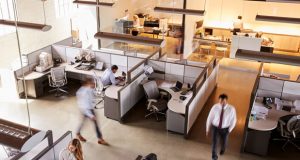Workplace pressures increasingly require a new approach to office design. Angela Love, Director at Active Workplace Solutions, discusses what the changing times mean for the world of workplace design and build
The quest for workplace talent rages on. Decision-makers are faced with low employee retention and productivity, driving the need to provide an attractive workplace that caters to a multi-generational workforce. As businesses set their sights and goals on Workplace 2030 and the coming decade of change, it’s important to consider not only how to prepare for today’s workforce, but crucially, tomorrow’s workplace too.
Facilities and workplace sectors are not alone in these concerns as other industries start to feel the pinch. A recent report found that 61 per cent of engineering businesses claimed they are ‘not confident’ there will be enough people with relevant qualifications to fill the highly skilled job vacancies on offer (see References, note 1).
But these pressures bring with them opportunities for change. Businesses hungry to succeed will proactively attempt to tackle and embrace these opportunities. FM providers and office designers have a real chance to deliver more value, not only to employees, but to the C-suite and decision-makers.
THE EMPLOYEE EXPERIENCE
 Over the past 20 years there has been a real shift in the working relationship between employer and employee. The archaic days where employees sat at their desks for eight hours at a time are over for many industries. Now, it’s all about the experience. Workplaces are expected to be unique, dynamic, innovative spaces. Employee satisfaction is closely linked to the quality of their working environment – and design is a good place to start.
Over the past 20 years there has been a real shift in the working relationship between employer and employee. The archaic days where employees sat at their desks for eight hours at a time are over for many industries. Now, it’s all about the experience. Workplaces are expected to be unique, dynamic, innovative spaces. Employee satisfaction is closely linked to the quality of their working environment – and design is a good place to start.
However, it’s important not to impose change. The workforce should be involved, consulted and engaged when it comes to the space they are expected to inhabit. It’s no longer about providing a sit-stand desk and announcing an agile working policy. It’s about changing your staff’s attitudes towards workplace change, spending time and effort to learn about your employees inside and outside the workplace and understanding what tools they need to perform to the best of their ability.
For example, if you are an SME situated in a picturesque rural area, there is a strong chance that your staff enjoy these surroundings. It might be the reason they targeted you as an employer. Clients and customers will likely enjoy visiting too. So, don’t attempt to hide this rural setting. Make it your USP. Make the most of every window, create outdoor spaces, utilise your environment and create a special place.
Equally, if you are in a high-rise city-based office, your staff are likely to be aware that much of their environment is artificial or processed, in terms of air, lighting and materials. You should consider pushing the boundaries to create a more natural, dynamic or fulfilling space. Living plant walls can assist greatly with air quality, for example (2), while vibrant colours can be used to distinguish areas for collaboration, relaxation and meetings. Even the names of meeting rooms can be influential. It’s the attention to small details that can go a long way towards improving engagement, productivity and overall happiness.
When designing and managing work environments that support the overall employee experience, savvy workplace managers will apply lessons from the academic disciplines of psychology and anthropology to ensure the spaces tick all the right boxes. This sexier side of the role is set to attract the next generation of future FMs. Decision-makers and workplace managers no longer need to be afraid of the challenge of a relocation, refurbishment or fit-out.
Of course, any workplace change has the potential for stress, and managers need to be particularly careful to avoid too much disruption. When a transformation is communicated clearly, executed smoothly and accurately reflects employees’ needs, this hugely improves the chances of a successful outcome.
 One of the greatest challenges facing designers and workplace managers today is the growing age gap between workers. For larger firms with hundreds, possibly thousands of employees in one building, having a 22-year-old working alongside someone 40 years their senior is not uncommon. It’s important to incorporate diverse areas and facilities that cater for multiple ages. This will provide growth opportunities, help everyone to embrace technology, ensure a work-life balance and keep the human touch.
One of the greatest challenges facing designers and workplace managers today is the growing age gap between workers. For larger firms with hundreds, possibly thousands of employees in one building, having a 22-year-old working alongside someone 40 years their senior is not uncommon. It’s important to incorporate diverse areas and facilities that cater for multiple ages. This will provide growth opportunities, help everyone to embrace technology, ensure a work-life balance and keep the human touch.
Agile and flexible working are rising at an unstoppable rate. Over 68 per cent of workers now work remotely to some degree (3), which creates a new workplace challenge. How can designers produce a space which caters for a workforce whose location is fluid and who may or not be in the office on any given day? The key is to unlock the potential in flexible space.




